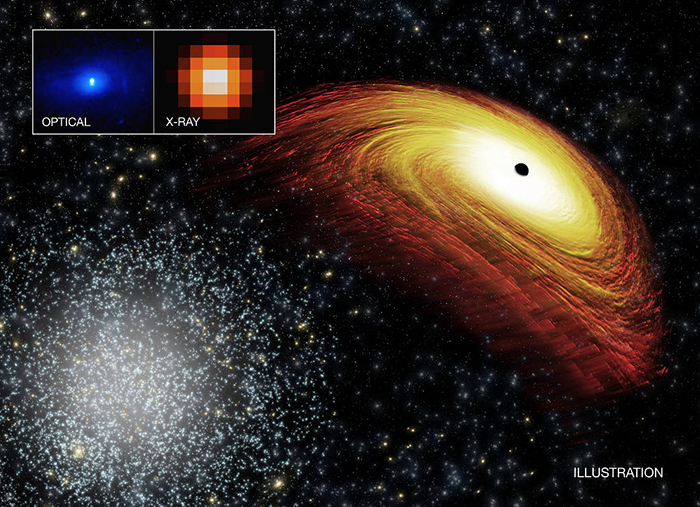Supermassive black holes normally sit at the centre of galaxies, pulling in matter and devouring stars that get too close, but now astronomers are tracking one that seems to be speeding across space.
Experts think this black hole might be recoiling – that's the official term for when two black holes collide and merge, and the variation in gravitational forces between these two enormous objects ends up propelling the resulting supermassive black hole rapidly through space.
If the find can be confirmed, it could tell us more about how these supermassive black holes form, shift, and evolve in space, which is why scientists are so eager to track and study it. These roving black holes don't come around very often.
The supermassive black hole was spotted after astronomers sifted through data on thousands of galaxies from NASA's Chandra X-Ray Observatory. It's thought to be some 3.9 billion light-years from Earth, and looks to be about 160 million times the mass of our Sun.
In the image below you can see data from Hubble (left inset) and Chandra (right inset), together with an artist's illustration.
 NASA
NASA
Scientists first focussed in on bright X-ray emissions – a common feature of supermassive black holes caused by the heating of material accelerating towards their event horizon – and then switched to Hubble Space Telescope observations to look for pairs of signal peaks close together, indicating either two supermassive black holes or a single recoiling one.
Finally, promising finds were cross-referenced against data from the Sloan Digital Sky Survey, which has mapped light signals across 35 percent of our sky. Closing in on one particularly promising candidate, astronomers discovered the black hole was travelling at a different velocity to its galaxy.
More evidence was found around the fringes of this galaxy, where signs of disturbance suggest two black holes recently merged. What's more, star formation rates seem to be above average here, another phenomenon linked to black hole mergers.
This isn't definitely a runaway black hole yet – there may be another black hole here too faint to see, the astronomers say – but it's worth investigating further. With additional data, the case could be settled.
As with previously discovered supermassive black holes that are potentially recoiling, also found with the help of Chandra, the data enables scientists to test out our hypotheses about how the universe fits together, and the influence black holes have.
The ultimate additional speed of a runaway black hole depends on the mass and spin of the two black holes that formed it, like balls colliding on a pool table, but they can reach thousands of kilometres or miles per second.
Compare that to the speed our Sun is moving – about 24 kilometres or 15 miles per second.
Thanks to the powerful telescopes astronomers now have access to, we're starting to spot more of these potentially recoiling supermassive black holes. Another candidate was flagged up a couple of months ago.
Astronomers aren't sure yet whether these speeding black holes are exactly what we think they are, but we're looking forward to the chase.
The research has been published in The Astrophysical Journal and is available on arXiv.org.
Full image credit: X-ray: NASA/CXC/NRAO/D.-C.Kim; Optical: NASA/STScI; Illustration: NASA/CXC/M.Weiss
